Hand cannon

| Part of a series on |
| Cannon |
|---|
 |
| History |
| Operation |
| By country |
| By type |
The hand cannon (Chinese: 手銃), also known as the gonne or handgonne, is the first true firearm and the successor of the fire lance.[1] It is the oldest type of small arms as well as the most mechanically simplistic form of metal barrel firearms. Unlike matchlock firearms it requires direct manual external ignition through a touch hole without any form of firing mechanism. It may also be considered a forerunner of the handgun. The hand cannon was widely used in China from the 13th century onward and later throughout Europe in the 14th century until at least the 1560s, when it was supplanted by the matchlock arquebus, which is the first firearm to have a trigger.[2]
History
Hand cannons first saw widespread usage in China sometime during the 13th century and spread from there to the rest of the world. In 1287 Yuan Jurchen troops deployed hand cannons in putting down a rebellion by the Mongol prince Nayan.[3] The earliest artistic depiction of a hand cannon – a rock sculpture found among the Dazu Rock Carvings – is dated to 1128, earlier than any recorded or precisely dated archaeological samples, so it is possible that the concept of a cannon-like firearm has existed since the 12th century.[4] The oldest extant hand cannon bearing a date of production is the Xanadu Gun, dated to 1298. The Heilongjiang hand cannon has been dated to no later than 1288, but this dating is based on contextual evidence; the gun bears no inscription or era date.[5] Other specimens also likely predate the Xanadu and Heilongjiang guns and have been traced back to the Western Xia period, but these too lack inscriptions and era dates.[6]
The earliest reliable evidence of hand cannons in Europe appeared in 1326 and evidence of their production can be dated as early as 1327.[7] The first recorded use of gunpowder weapons in Europe was in 1331 when two mounted Germanic knights attacked Cividale del Friuli with gunpowder weapons of some sort. By 1338 hand cannons were in widespread use in France.[8] During the 14th century the Arabs seem to have used the hand cannon to some degree.[9] Cannons are attested to in India starting from 1366.[10] The Joseon kingdom in Korea acquired knowledge of gunpowder from China by 1374 and started producing cannons by 1377.[9] In Southeast Asia Đại Việt soldiers were using hand cannons at the very latest by 1390 when they employed them in killing the king of Champa, Che Bong Nga.[11] Japan was already aware of gunpowder warfare due to the Mongol invasions during the 13th century, but cannons were not mentioned until 1510 when a monk acquired one during his travels in China,[12] and firearms were not produced until 1543, when the Portuguese introduced matchlocks which were known as tanegashima to the Japanese.[13]
Improvements in hand cannon and gunpowder technology – corned powder, shot ammunition, and development of the flash pan – led to the invention of the arquebus in late 15th-century Europe.[14]
Design and features
The hand cannon consists of a barrel, a handle, and sometimes a socket to insert a wooden stock. Extant samples show that some hand cannons also featured a metal extension as a handle.[15]
The hand cannon could be held in two hands, but another person is often shown aiding in the ignition process using smoldering wood, coal, red-hot iron rods, or slow-burning matches. The hand cannon could be placed on a rest and held by one hand, while the gunner applied the means of ignition himself.[2]
Projectiles used in hand cannons were known to include rocks, pebbles, and arrows. Eventually stone projectiles in the shape of balls became the preferred form of ammunition, and then they were replaced by iron balls from the late 14th to 15th centuries.[16]
Later hand cannons have been shown to include a flash pan attached to the barrel and a touch hole drilled through the side wall instead of the top of the barrel. The flash pan had a leather cover and, later on, a hinged metal lid, to keep the priming powder dry until the moment of firing and to prevent premature firing. These features were carried over to subsequent firearms.[17]
The invention of corned powder, the slow match, and the serpentine lever in mid-15th-century Europe led to the development of the first matchlock firearms, which could be more effectively aimed and fired than hand cannon.
Gallery
 The figure carrying the hand cannon, with its flames and ball issuing forth. The ball is no longer present, leaving a round indentation.
The figure carrying the hand cannon, with its flames and ball issuing forth. The ball is no longer present, leaving a round indentation. Discovered in 1980, Gansu, late Western Xia (1214-1227). The Wuwei Bronze Gun is 100cm in length and weighs 108.5kg.
Discovered in 1980, Gansu, late Western Xia (1214-1227). The Wuwei Bronze Gun is 100cm in length and weighs 108.5kg.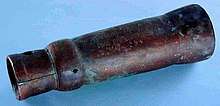 Discovered in the ruins of Xanadu (Shangdu 上都), the Mongol Summer Palace, Inner Mongolia. The Xanadu Gun is 34.7cm in length and weighs 6.2kg. Dated to 1298.
Discovered in the ruins of Xanadu (Shangdu 上都), the Mongol Summer Palace, Inner Mongolia. The Xanadu Gun is 34.7cm in length and weighs 6.2kg. Dated to 1298.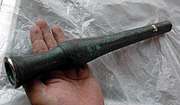 Discovered in Ningxia. This firearm is 34.6cm long, the muzzle 2.6cm in diameter, and weighs 1.55 kilograms.
Discovered in Ningxia. This firearm is 34.6cm long, the muzzle 2.6cm in diameter, and weighs 1.55 kilograms.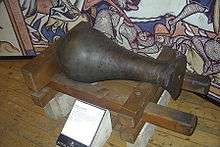 Reconstruction of an arrow-firing cannon that appears in a 1326 manuscript.
Reconstruction of an arrow-firing cannon that appears in a 1326 manuscript.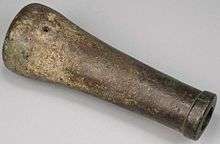 Possibly the oldest surviving firearm in Europe, the Loshult gun was discovered in 1861 by a farmer in a Swedish parish, which the gun is named after. The Loshult gun is dated to the mid-14th century, 1330-50.
Possibly the oldest surviving firearm in Europe, the Loshult gun was discovered in 1861 by a farmer in a Swedish parish, which the gun is named after. The Loshult gun is dated to the mid-14th century, 1330-50. Western European handgun, 1380. 18 cm-long and weighing 1.04 kg, it was fixed to a wooden pole to facilitate manipulation. Musée de l'Armée.
Western European handgun, 1380. 18 cm-long and weighing 1.04 kg, it was fixed to a wooden pole to facilitate manipulation. Musée de l'Armée. The Mörkö gun is another early Swedish firearm discovered by a fisherman in the Baltic Sea at the coast of Södermansland near Nynäs in 1828. It has been given a date of ca. 1390.
The Mörkö gun is another early Swedish firearm discovered by a fisherman in the Baltic Sea at the coast of Södermansland near Nynäs in 1828. It has been given a date of ca. 1390. The Tannenberg handgonne is a cast bronze firearm. Muzzle bore 15-16 mm. Found in the water well of the 1399 destroyed Tannenberg castle. Oldest surviving firearm from Germany.
The Tannenberg handgonne is a cast bronze firearm. Muzzle bore 15-16 mm. Found in the water well of the 1399 destroyed Tannenberg castle. Oldest surviving firearm from Germany.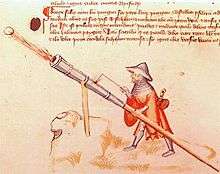 Hand cannon being fired from a stand, Bellifortis, manuscript, by Konrad Kyeser, 1405
Hand cannon being fired from a stand, Bellifortis, manuscript, by Konrad Kyeser, 1405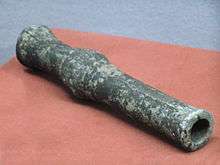 Hand cannon from the Mongol Yuan dynasty (1271–1368)
Hand cannon from the Mongol Yuan dynasty (1271–1368) "Hand bombard", France, 1390–1400
"Hand bombard", France, 1390–1400.jpg) A 10-shot hand cannon (handgonne), unknown age and origin.
A 10-shot hand cannon (handgonne), unknown age and origin.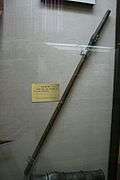 A socketed Ming hand cannon, 1505.
A socketed Ming hand cannon, 1505.
See also
Citations
- ↑ Patrick 1961, p. 6.
- 1 2 Andrade 2016, p. 76.
- ↑ Andrade 2016, p. 53.
- ↑ Lu 1988.
- ↑ Chase 2003, p. 32.
- ↑ Needham 1986, p. 304.
- ↑ Andrade 2016, p. 75.
- ↑ Andrade 2016, p. 77.
- 1 2 Chase 2003.
- ↑ Khan 2004, p. 9-10.
- ↑ Tian 2006, p. 75.
- ↑ Needham 1986, p. 430.
- ↑ Lidin 2002, p. 1-14.
- ↑ Partington 1999, p. 123.
- ↑ Andrade 2016, p. 80.
- ↑ Andrade 2016, p. 105.
- ↑ Needham 1986, p. 289.
References
- Adle, Chahryar (2003), History of Civilizations of Central Asia: Development in Contrast: from the Sixteenth to the Mid-Nineteenth Century
- Ágoston, Gábor (2008), Guns for the Sultan: Military Power and the Weapons Industry in the Ottoman Empire, Cambridge University Press, ISBN 0-521-60391-9
- Agrawal, Jai Prakash (2010), High Energy Materials: Propellants, Explosives and Pyrotechnics, Wiley-VCH
- Andrade, Tonio (2016), The Gunpowder Age: China, Military Innovation, and the Rise of the West in World History, Princeton University Press, ISBN 978-0-691-13597-7 .
- Arnold, Thomas (2001), The Renaissance at War, Cassell & Co, ISBN 0-304-35270-5
- Benton, Captain James G. (1862). A Course of Instruction in Ordnance and Gunnery (2 ed.). West Point, New York: Thomas Publications. ISBN 1-57747-079-6.
- Brown, G. I. (1998), The Big Bang: A History of Explosives, Sutton Publishing, ISBN 0-7509-1878-0 .
- Buchanan, Brenda J., ed. (2006), Gunpowder, Explosives and the State: A Technological History, Aldershot: Ashgate, ISBN 0-7546-5259-9
- Chase, Kenneth (2003), Firearms: A Global History to 1700, Cambridge University Press, ISBN 0-521-82274-2 .
- Cocroft, Wayne (2000), Dangerous Energy: The archaeology of gunpowder and military explosives manufacture, Swindon: English Heritage, ISBN 1-85074-718-0
- Cowley, Robert (1993), Experience of War, Laurel .
- Cressy, David (2013), Saltpeter: The Mother of Gunpowder, Oxford University Press
- Crosby, Alfred W. (2002), Throwing Fire: Projectile Technology Through History, Cambridge University Press, ISBN 0-521-79158-8 .
- Curtis, W. S. (2014), Long Range Shooting: A Historical Perspective, WeldenOwen .
- Earl, Brian (1978), Cornish Explosives, Cornwall: The Trevithick Society, ISBN 0-904040-13-5 .
- Easton, S. C. (1952), Roger Bacon and His Search for a Universal Science: A Reconsideration of the Life and Work of Roger Bacon in the Light of His Own Stated Purposes, Basil Blackwell
- Ebrey, Patricia B. (1999), The Cambridge Illustrated History of China, Cambridge University Press, ISBN 0-521-43519-6
- Grant, R.G. (2011), Battle at Sea: 3,000 Years of Naval Warfare, DK Publishing .
- Hadden, R. Lee. 2005. "Confederate Boys and Peter Monkeys." Armchair General. January 2005. Adapted from a talk given to the Geological Society of America on March 25, 2004.
- Harding, Richard (1999), Seapower and Naval Warfare, 1650–1830, UCL Press Limited
- al-Hassan, Ahmad Y. (2001), "Potassium Nitrate in Arabic and Latin Sources", History of Science and Technology in Islam, retrieved 23 July 2007 .
- Hobson, John M. (2004), The Eastern Origins of Western Civilisation, Cambridge University Press .
- Johnson, Norman Gardner. "explosive". Encyclopædia Britannica. Chicago: Encyclopædia Britannica Online.
- Kelly, Jack (2004), Gunpowder: Alchemy, Bombards, & Pyrotechnics: The History of the Explosive that Changed the World, Basic Books, ISBN 0-465-03718-6 .
- Khan, Iqtidar Alam (1996), "Coming of Gunpowder to the Islamic World and North India: Spotlight on the Role of the Mongols", Journal of Asian History, 30: 41–5 .
- Khan, Iqtidar Alam (2004), Gunpowder and Firearms: Warfare in Medieval India, Oxford University Press
- Khan, Iqtidar Alam (2008), Historical Dictionary of Medieval India, The Scarecrow Press, Inc., ISBN 0-8108-5503-8
- Kinard, Jeff (2007), Artillery An Illustrated History of its Impact
- Konstam, Angus (2002), Renaissance War Galley 1470-1590, Osprey Publisher Ltd. .
- Liang, Jieming (2006), Chinese Siege Warfare: Mechanical Artillery & Siege Weapons of Antiquity, Singapore, Republic of Singapore: Leong Kit Meng, ISBN 981-05-5380-3
- Lidin, Olaf G. (2002), Tanegashima – The Arrival of Europe in Japan, Nordic Inst of Asian Studies, ISBN 8791114128
- Lorge, Peter A. (2008), The Asian Military Revolution: from Gunpowder to the Bomb, Cambridge University Press, ISBN 978-0-521-60954-8
- Lu, Gwei-Djen (1988), "The Oldest Representation of a Bombard", Technology and Culture, 29: 594–605
- McLachlan, Sean (2010), Medieval Handgonnes
- McNeill, William Hardy (1992), The Rise of the West: A History of the Human Community, University of Chicago Press .
- Morillo, Stephen (2008), War in World History: Society, Technology, and War from Ancient Times to the Present, Volume 1, To 1500, McGraw-Hill, ISBN 978-0-07-052584-9
- Needham, Joseph (1980), Science & Civilisation in China, 5 pt. 4, Cambridge University Press, ISBN 0-521-08573-X
- Needham, Joseph (1986), Science & Civilisation in China, V:7: The Gunpowder Epic, Cambridge University Press, ISBN 0-521-30358-3 .
- Nicolle, David (1990), The Mongol Warlords: Ghengis Khan, Kublai Khan, Hulegu, Tamerlane
- Nolan, Cathal J. (2006), The Age of Wars of Religion, 1000–1650: an Encyclopedia of Global Warfare and Civilization, Vol 1, A-K, 1, Westport & London: Greenwood Press, ISBN 0-313-33733-0
- Norris, John (2003), Early Gunpowder Artillery: 1300–1600, Marlborough: The Crowood Press .
- Partington, J. R. (1960), A History of Greek Fire and Gunpowder, Cambridge, UK: W. Heffer & Sons .
- Partington, J. R. (1999), A History of Greek Fire and Gunpowder, Baltimore: Johns Hopkins University Press, ISBN 0-8018-5954-9
- Patrick, John Merton (1961), Artillery and warfare during the thirteenth and fourteenth centuries, Utah State University Press .
- Pauly, Roger (2004), Firearms: The Life Story of a Technology, Greenwood Publishing Group .
- Perrin, Noel (1979), Giving up the Gun, Japan's reversion to the Sword, 1543–1879, Boston: David R. Godine, ISBN 0-87923-773-2
- Petzal, David E. (2014), The Total Gun Manual (Canadian edition), WeldonOwen .
- Phillips, Henry Prataps (2016), The History and Chronology of Gunpowder and Gunpowder Weapons (c.1000 to 1850), Notion Press
- Purton, Peter (2010), A History of the Late Medieval Siege, 1200–1500, Boydell Press, ISBN 1-84383-449-9
- Robins, Benjamin (1742), New Principles of Gunnery
- Rose, Susan (2002), Medieval Naval Warfare 1000-1500, Routledge
- Roy, Kaushik (2015), Warfare in Pre-British India, Routledge
- Schmidtchen, Volker (1977a), "Riesengeschütze des 15. Jahrhunderts. Technische Höchstleistungen ihrer Zeit", Technikgeschichte 44 (2): 153–173 (153–157)
- Schmidtchen, Volker (1977b), "Riesengeschütze des 15. Jahrhunderts. Technische Höchstleistungen ihrer Zeit", Technikgeschichte 44 (3): 213–237 (226–228)
- Tran, Nhung Tuyet (2006), Viêt Nam Borderless Histories, University of Wisconsin Press .
- Turnbull, Stephen (2003), Fighting Ships Far East (2: Japan and Korea Ad 612–1639, Osprey Publishing, ISBN 1-84176-478-7
- Urbanski, Tadeusz (1967), Chemistry and Technology of Explosives, III, New York: Pergamon Press .
- Villalon, L. J. Andrew (2008), The Hundred Years War (part II): Different Vistas, Brill Academic Pub, ISBN 978-90-04-16821-3
- Wagner, John A. (2006), The Encyclopedia of the Hundred Years War, Westport & London: Greenwood Press, ISBN 0-313-32736-X
- Watson, Peter (2006), Ideas: A History of Thought and Invention, from Fire to Freud, Harper Perennial (2006), ISBN 0-06-093564-2
- Willbanks, James H. (2004), Machine guns: an illustrated history of their impact, ABC-CLIO, Inc.
External links
| Wikimedia Commons has media related to Hand cannon (handgonne). |